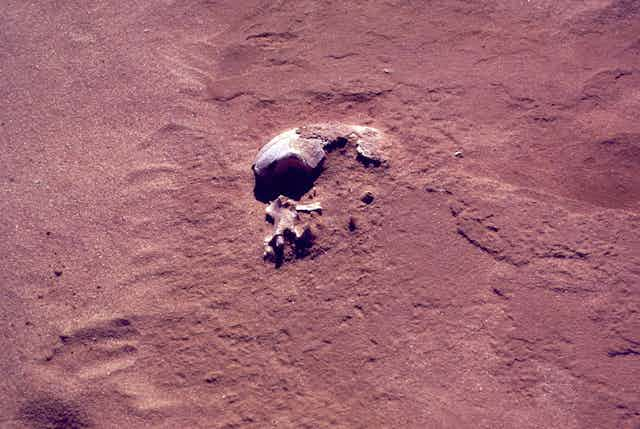The question of whether Aboriginal People were the First Australians may be unanimously accepted today but research published back in 2001 suggested the contrary.
A new study out this week shows how we re-examined the research and our results put an end to that controversy.
The 2001 study, by the Australian National University’s Gregory Adcock and colleagues, attained international significance, although its conclusions have remained controversial.
The authors published what was argued to be DNA sequences from Mungo Man, the oldest Australian, and from the remains of nine other ancient Aboriginal Australians.
One of the most important landmark claims by the authors was that the ancient DNA sequence of Mungo Man showed high divergence from the sequences of contemporary humans, including those from Aboriginal Australians.
Hence they suggested that Mungo Man belonged to an early human lineage, which is not related to modern Aboriginal Australians.
An ‘older’ First Australian?
The implications of these claims were profound. They suggested multiple waves of migration to Australia, with an older more divergent population, which included Mungo Man, being replaced by a more recent population consisting of contemporary Aboriginal Australians.
The paper supported the hypothesis of modern human origins of the late Alan Thorne, who was also from ANU and an author of the paper.
Thorne had argued that Aboriginal origins were the result of two independent migrations, one of which was from a population whose origins were firmly linked with ancient Java (Indonesia).
The report of an extinct modern human lineage recovered from ancient DNA, he argued, supported his views on modern human origins. He said that we could no longer consider modern human origins to be solely African.
Naturally, the suggestion that contemporary Aboriginal Australians were not the true First Peoples of Australia resulted in heated debate.
The scientists who had done the research had not necessarily said exactly this. But this was how it was being portrayed, including on the front page of The Australian newspaper.
These controversial findings were further challenged by other researchers who questioned the authenticity of the sequences reported. They highlighted problems with the methods used to analyse the DNA sequences they recovered and there were concerns about the validity of the conclusions by the authors.
It is worth noting that Adcock and his colleagues rebutted some of these criticisms. They defended their conclusions about modern human origins, particularly with regard to the phylogenetic placement of Mungo Man.
Re-testing the results
Given the obvious importance of these claims, particularly in terms of the social question of who the First Australians really were, it deserved serious re-evaluation. This was possible using more recent advances in DNA methods and powerful analytical approaches.

To assess the results obtained by the original research we were given consent from the Willandra Lakes World Heritage Area Aboriginal Elders Committee – comprising the Parkindji, Ngiyampa and Muthi Muthi elders – to re-sample material from this important fossil series.
This research, published this week in the Proceedings of the National Academy of Sciences, disputes these earlier claims.
Using more advanced second-generation DNA sequencing methods provides strong evidence that the DNA sequences originally reported by Adcock and colleagues were likely artefacts of the method used.
The polymerase chain reaction (PCR) technique used in the original study can produce unique hybrid molecules from different DNA templates. Whatever, the sequences reported previously were certainly not from Aboriginal Australians.
This new study was unable to replicate a single sequence published in the earlier study, with the exception of a sequence listed as belonging to Adcock himself, despite using some of the original extracts.
Finding contamination
The sample from Mungo Man that was re-sequenced in the new study contained sequences from five different European people, clearly representing contamination that may be due to handling throughout the years.
Among the other remains analysed was one man who was buried close to the location where Mungo Man was originally interred. The present study successfully recovered ancient DNA from this man. It represents the first recovery of a mitochondrial genome from an ancient Aboriginal person who lived before the arrival of Europeans.
The mitochondrial sequence was found to belong to a haplotype (grouping of human populations based on mitochondrial DNA) S2. This is exclusively found among contemporary Aboriginal Australian populations.
The present study is important for many reasons, but perhaps most importantly it has been planned and conducted, and is published, with the support of the Barkindji, Ngiyampaa and Muthi Muthi indigenous groups.
Finally, this new study refutes the earlier suggestion that another extinct lineage of people predated Aboriginal Australians. The archaeology and the genetics provide very strong evidence that our First People have been here over the past 50,000 years. This was long before people first arrived in Europe.

